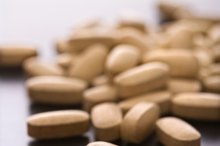Vitamins to Treat Yellow Skin
Yellow skin -- also referred to as jaundice -- is the result of too much bilirubin. According to the National Institutes of Health, bilirubin is a yellow chemical found in hemoglobin -- the substance responsible for carrying oxygen to your red blood cells 3. If your liver cannot successfully break down blood cells, your skin may appear yellow. Jaundice can be the result of liver disease, blood disease, blocked bile ducts, genetic syndromes and infections. Vitamins may be able to help with the appearance of yellow skin. Jaundice can also occur in newborns. Always consult your doctor prior to beginning a vitamin regimen.
Riboflavin
Ribflavin -- or vitamin B-2 -- is often supplemented in newborns experiencing neonatal jaundice, according to "The Vitamin Book." Riboflavin is part of the vitamin B complex, a group of eight vitamins responsible for metabolizing food into fuel sources that can be used by the body. Riboflavin is a light-sensitive vitamin that is often used in conjunction with phototherapy to help reduce neonatal jaundice. Vitamin B-2 is given to newborns through injections, oral drops or intravenous medications.
- Ribflavin -- or vitamin B-2 -- is often supplemented in newborns experiencing neonatal jaundice, according to "The Vitamin Book."
- Riboflavin is a light-sensitive vitamin that is often used in conjunction with phototherapy to help reduce neonatal jaundice.
Vitamin B-12
What Are the Benefits of Vitamin B-1 or Thiamine?
Learn More
Vitamin B-12 is a key nutrient that is involved in many of the functions of your body, including DNA synthesis and the formation of red blood cells. This vitamin is found in many foods sources, including fish, beef liver and clams. A symptom of a vitamin B-12 deficiency can include jaundice -- or yellowing of the skin -- according to "The Vitamin Book." If you suspect a vitamin B-12 deficiency and are experiencing jaundice, contact your health-care provider 3. Your doctor may recommend dietary supplements or vitamin B-12 injections. Your doctor may also suggest increasing your vitamin B-12 intake through fortified foods such as cereal and bread.
- Vitamin B-12 is a key nutrient that is involved in many of the functions of your body, including DNA synthesis and the formation of red blood cells.
- Your doctor may also suggest increasing your vitamin B-12 intake through fortified foods such as cereal and bread.
Vitamin A
According to KidsHealth.org, vitamin A plays a key role in the maintenance of your vision and it also boosts your immune system. Vitamin A is found in fortified milk, liver, orange fruits, orange vegetables and dark, green, leafy vegetables. However, too much of a food can result in vitamin A toxicity. Symptoms of vitamin A toxicity include jaundice, mouth sores, hair loss and itching. Symptoms of jaundice and vitamin A toxicity can be reversed by consuming a diet low in vitamin A and beta-carotene. Beta-carotene is a precursor of vitamin A that is less toxic.
- According to KidsHealth.org, vitamin A plays a key role in the maintenance of your vision and it also boosts your immune system.
- Symptoms of jaundice and vitamin A toxicity can be reversed by consuming a diet low in vitamin A and beta-carotene.
Vitamin C
Vitamins for Mononucleosis
Learn More
Vitamin C -- or ascorbic acid -- is a vitamin known for helping to boost the immune system. Vitamin C is found in berries, citrus fruits, sweet red peppers, tomatoes, broccoli and cabbage. According to "The Vitamin Book," vitamin C can help to reduce the effects of jaundice. Vitamin C helps to neutralize the harmful toxins in your body that cause jaundice and works to remove them from your body. Vitamin C is a powerful antioxidant that can help to prevent disease and infection from turning your skin yellow.
- Vitamin C -- or ascorbic acid -- is a vitamin known for helping to boost the immune system.
- Vitamin C is a powerful antioxidant that can help to prevent disease and infection from turning your skin yellow.
Related Articles
References
- "The Vitamin Book": Harold M. Silverman, Joseph Romano and Gary Elmer; 2003
- KidsHealth.org: Vitamins; Mary L. Gavin, MD; Jan. 2011
- National Institutes of Health: Jaundice
- Holick MF, Gordon CM. Patient Guide to Vitamin D Deficiency. The Journal of Clinical Endocrinology & Metabolism. 2011;96(7):1-2. doi:10.1210/jcem.96.7.zeg33a
- Sunyecz JA. The use of calcium and vitamin D in the management of osteoporosis. Ther Clin Risk Manag. 2008;4(4):827-836. doi:10.2147/tcrm.s3552
- Giovannucci E, Liu Y, Hollis BW, Rimm EB. 25-hydroxyvitamin D and risk of myocardial infarction in men: a prospective study. Arch Intern Med. 2008;168(11):1174-1180. doi:10.1001/archinte.168.11.1174
- Gorham ED, Garland CF, Garland FC, et al. Optimal vitamin D status for colorectal cancer prevention: a quantitative meta analysis. Am J Prev Med. 2007;32(3):210-216. doi:10.1016/j.amepre.2006.11.004
- Lappe JM, Travers-Gustafson D, Davies KM, Recker RR, Heaney RP. Vitamin D and calcium supplementation reduces cancer risk: results of a randomized trial. The American Journal of Clinical Nutrition. 2007;85(6):1586-1591. doi:10.1093/ajcn/85.6.1586
- Prentice RL, Pettinger MB, Jackson RD, et al. Health risks and benefits from calcium and vitamin D supplementation: Women’s Health Initiative clinical trial and cohort study. Osteoporos Int. 2013;24(2):567-580. doi:10.1007/s00198-012-2224-2
- Urashima M, Segawa T, Okazaki M, Kurihara M, Wada Y, Ida H. Randomized trial of vitamin D supplementation to prevent seasonal influenza A in schoolchildren. Am J Clin Nutr. 2010;91(5):1255-1260. doi:10.3945/ajcn.2009.29094
- Salehpour A, Hosseinpanah F, Shidfar F, et al. A 12-week double-blind randomized clinical trial of vitamin D₃ supplementation on body fat mass in healthy overweight and obese women. Nutr J. 2012;11:78. doi:10.1186/1475-2891-11-78
- Carrillo AE, Flynn MG, Pinkston C, et al. Impact of vitamin D supplementation during a resistance training intervention on body composition, muscle function, and glucose tolerance in overweight and obese adults. Clin Nutr. 2013;32(3):375-381. doi:10.1016/j.clnu.2012.08.014
- Marcinowska-Suchowierska E, Kupisz-Urbańska M, Łukaszkiewicz J, Płudowski P, Jones G. Vitamin D Toxicity-A Clinical Perspective. Front Endocrinol. 2018;9:550. doi:10.3389/fendo.2018.00550
- Ross AC, Manson JE, Abrams SA, et al. The 2011 report on dietary reference intakes for calcium and vitamin D from the Institute of Medicine: what clinicians need to know. J Clin Endocrinol Metab. 2011;96(1):53-58. doi:10.1210/jc.2010-2704
- Bouillon R, Van Schoor NM, Gielen E, et al. Optimal vitamin D status: a critical analysis on the basis of evidence-based medicine. J Clin Endocrinol Metab. 2013;98(8):E1283-E1304. doi:10.1210/jc.2013-1195
- American Academy of Dermatology. Position Statement of Vitamin D. 2010.
- Taksler GB, Cutler DM, Giovannucci E, Keating NL. Vitamin D deficiency in minority populations. Public Health Nutr. 2015;18(3):379-391. doi:10.1017/S1368980014000457
- Holick MF, Binkley NC, Bischoff-Ferrari HA, et al. Evaluation, treatment, and prevention of vitamin D deficiency: an Endocrine Society clinical practice guideline. J Clin Endocrinol Metab. 2011;96(7):1911-1930. doi:10.1210/jc.2011-0385
- Cannell JJ, Vieth R, Umhau JC, et al. Epidemic Influenza and Vitamin D. Epidemiol Infect. 2006; 134:1129-40.
- Carrillo AE1, Flynn MG, Pinkston C, Markofski MM, Jiang Y, Donkin SS, Teegarden D. Impact of Vitamin D Supplementation During a Resistance Training Intervention on Body Composition, Muscle Function, and Glucose Tolerance in Overweight and Obese Adults. Clin Nutr. 2013 Jun;32(3):375-81. doi: 10.1016/j.clnu.2012.08.014. Epub 2012 Aug 31.
- Ginde AA, Mansbach JM, Camargo CA, Jr. Association Between Serum 25-Hydroxyvitamin D Level and Upper Respiratory Tract Infection in the Third National Health and Nutrition Examination Survey. Arch Intern Med. 2009; 169:384-90.
- Giovannucci E, Liu Y, Hollis BW, Rimm EB. 25-hydroxyvitamin D and Risk of Myocardial Infarction in Men: a Prospective Study. Arch Intern Med. 2008; 168:1174-80.
- Gorham ED, Garland CF, Garland FC, Grant WB, Mohr SB, Lipkin M, Newmark HL, Giovannucci E, Wei M, Holick MF. Optimal Vitamin D Status for Colorectal Cancer Prevention: a Quantitative Meta-analysis. Am J Prev Med. 2007 Mar;32(3):210-6.
- Heaney, Robert P. “The Vitamin D Requirement in Health and Disease.” The Journal of Steroid Biochemistry & Molecular Biology 97 (2005):13-9.
- Holick MF. Vitamin D. In: Shils M, Olson J, Shike M, Ross AC, ed. Modern Nutrition in Health and Disease, 9th ed. Baltimore: Williams and Wilkins, 1999.
- National Institutes of Health Office of Dietary Supplements. Vitamin D: Dietary Supplement Fact Sheet. University of Ottawa Evidence-based Practice Center. Effectiveness and Safety of Vitamin D in Relation to Bone Health. Agency for Healthcare Research and Quality. Aug 2007: 07-E013.
- Salehpour A1, Hosseinpanah F, Shidfar F, Vafa M, Razaghi M, Dehghani S, Hoshiarrad A, Gohari M. A 12-week Double-blind Randomized Clinical Trial of Vitamin D₃ Supplementation on Body Fat Mass in Healthy Overweight and Obese Women. Nutr J. 2012 Sep 22;11:78. doi: 10.1186/1475-2891-11-78.
- Urashima M, Segawa T, Okazaki M, Kurihara M, Wada Y, Ida H. Randomized Trial of Vitamin D Supplementation to Prevent Seasonal Influenza A in Schoolchildren. Am J Clin Nutr. 2010 91:1255-60. Epub 2010 Mar 10.
- Wilkins, Consuelo H. and Yvette I. Sheline, et al. “Vitamin D Deficiency Is Associated with Low Mood and Worse Cognitive Performance in Older Adults.” American Journal of Geriatric Psychiatry 14 (2006): 1032-40.
Writer Bio
Michelle Zehr started writing professionally in 2009. She has written on health, fitness, fashion, interior design, home decorating,sports and finance for several websites. Zehr possesses a Bachelor of Arts in communication from the University of Pittsburgh, a Master of Arts in professional writing from Chatham University and a graduate certificate in health promotion from California University of Pennsylvania.









